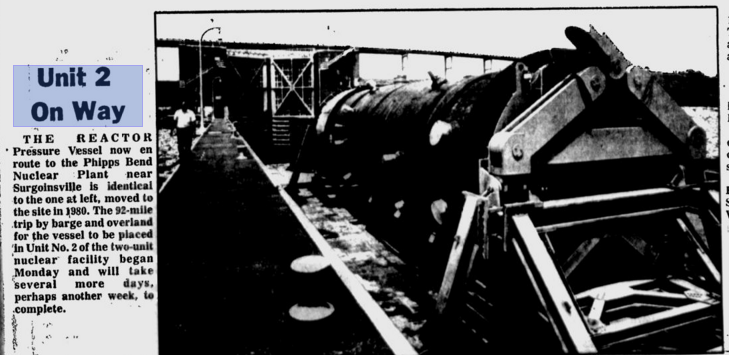1981: Did the U.S. trade A Phipps Bend nuclear reactor for the release of the U.S. embassy hostages in Iran?
The National Security Archive at George Washington University, Electronic Briefing Book No. 268 states:
“…two U.S. presidents dealing with the Shah of Iran, Ford and Carter, put concerns over proliferation and the Shah’s possible desire to build a nuclear bomb front and center when they approved negotiating positions for a deal to sell nuclear reactors to Iran.” (1)
We’re told the Iranian Revolution of 1979 killed the deal- but did it?
November 4, 1979: 52 Americans from the U.S. Embassy in Tehran were taken hostage, and held for 444 days. Remember, up until this crisis and the revolution, plans had been made to sell nuclear reactors to Iran.
Is it possible the U.S. was pressured to honor the original agreement? Did we send the second missing Phipps Bend reactor pressure vessel to Iran in order to secure the hostages’ release? We are given the fake news article about its arrival in Phipps Bend in June, 1981:
The Chicago Iron and Bridge worker interviewed in May of 2016 said he wasn’t sure what ultimately happened to the second vessel, but he did know it had not been sent to Phipps Bend. He said, “several RPVs were being stored onsite in Memphis” at the time.
Sending a nuclear reactor to Iran wouldn’t have been the most popular move an already unpopular President could have made. If this did happen, it well explains the lies and secrecy fed to the American public concerning the second reactor.
The U.S. had given Iran a nuclear reactor once before
In 1957, The United States and Iran signed the Atoms for Peace nuclear cooperation agreement:
“…an agreement that provides for technical assistance, the lease of several kilograms of enriched uranium, and cooperation on research on the peaceful uses of nuclear energy.” (3)
In 1967, the Tehran Nuclear Research Center is built:
“It has a 5-megawatt pool-type thermal research reactor supplied by the United States and is to be operated by the Atomic Energy Organization of Iran…(In November) the reactor at Tehran Nuclear Research Center goes critical, using 93 percent enriched uranium supplied by the United States.” (3)
In the article, “How Iran became a “Nuclear State” by Jeremy Bernstein, the author states:
When the TRR (Tehran Research Reactor) initially needed new fuel elements it was shortly before the 1979 revolution, and the Iranians chose simply to replace the TRR with a new, safer model of reactor designed in part by Freeman Dyson and manufactured by the San Diego firm General Atomics, which they ordered and paid for. Before it could be delivered, however, the revolution came and General Atomics’ export license was revoked. (4)
Iran has now paid for a nuclear reactor it appears they won’t receive, in addition to paying an additional $400 million to the United States for military equipment prior to the 1979 uprising. But the nuclear reactor they paid for back in 1979 was never brought up again. Was this reactor a secret part of the 1980-1981 hostage negotiations?
“The major issue between the two governments was a $400 million payment for military equipment made by the government of the Shah of Iran, prior to the 1979 uprising that toppled him. The U.S. banned delivery of the jets and other weapons amid the hostage crisis, but froze the $400 million advance payment.”(5)
Notice the issue of the paid-for reactor they (supposedly) did not receive is not mentioned.
The Barack Obama administration repaid the $400 million 35 years later…in addition to $1.3 billion in interest. This payment happened to coincide with a new nuclear agreement with Iran and another hostage release, the five Americans held in Tehran:
The White House repeatedly insisted that the nuclear deal must be kept a separate issue from the cases of the detained Americans, but the nuclear talks have helped significantly open up avenues of communication between the two countries that had been little used since the U.S. cut ties in 1980. (6)
It’s almost as if Iran has learned how to make the United States keep its nuclear promises.
(1) The National Security Archive. “The Nuclear Vault: U.S.-Iran Nuclear Negotiations in 1970s Featured Shah’s Nationalism and U.S. Weapons Worries.” Burr, William., Jan. 13, 2009.
(2) The Kingsport Daily News. “Unit 2 on Way.” June, 1981.
(3) Iran’s Weapons of Mass Destruction: the Real and Potential Threat. Cordesman and Al-Rodhan. The CSIS Press (Center for Strategic and International Studies.) 2006.
(4) “How Iran became a ‘Nuclear State.'” Jeremy Bernstein. The New York Review of Books. Feb. 19, 2010.
(5) “5 Things You Need to Know About the $400 Million America Sent to Iran.” Fortune.com. Shawn Tully. Aug. 5, 2016.
(6) “Iran releases 5 detained Americans, including Washington Post reporter.” Nahal Toosi. Jan. 16, 2016. Politico.
